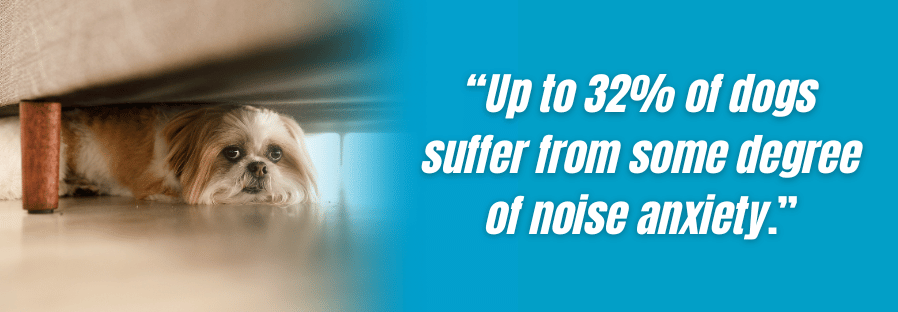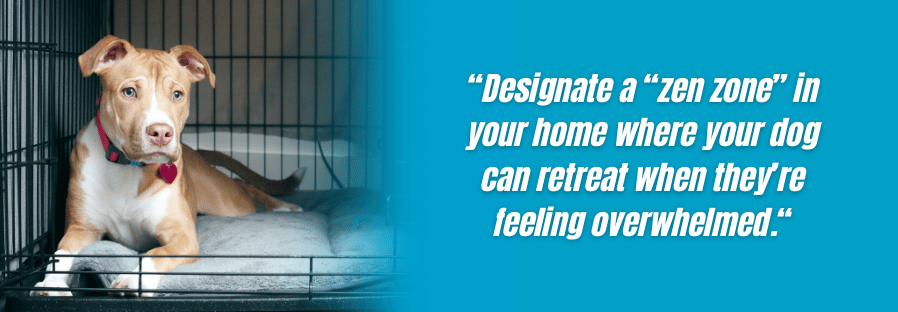How to Help Dogs with Anxiety During Fireworks and Storms
Start Preparing Now—Before Summer Hits
As the days grow longer and warmer, summer may feel just around the corner. And while many of us look forward to cookouts, lake days, and July 4th celebrations, our dogs often experience something very different: stress, fear, and panic.
If your dog struggles with noise phobia—fear of loud sounds like fireworks or thunderstorms—now is the time to start preparing. Training and desensitization take time and consistency, so don’t wait until the first summer storm hits to start helping your dog feel safe.
In this blog, we’ll cover practical, proven strategies to help your dog cope with fireworks and thunderstorm anxiety—and why spring is the perfect time to get started.
Why Do Dogs Fear Fireworks and Thunderstorms?
Loud, unpredictable sounds can be incredibly frightening for dogs. They don’t understand what’s happening, and the sudden booms, bright flashes, and changes in barometric pressure can send them into a panic.
Dogs with noise sensitivity or noise phobia may experience:
Trembling, shaking, or pacing
Hiding or trying to escape
Panting or drooling excessively
Barking, whining, or howling
Destructive behaviors or accidents in the house
Sound familiar? You’re not alone. It’s estimated that up to 32% of dogs suffer from some degree of noise anxiety.
Why Start Training in Spring?
Training a dog to feel calmer during fireworks and storms isn’t a one-and-done fix. It takes gradual exposure, positive associations, and time for your dog’s brain and body to feel safe in the presence of loud sounds.
By starting in the spring, you give your dog weeks (or even months!) to practice before summer fireworks and storms hit full swing. This proactive approach helps reduce stress, not just for your dog, but for you too.
How to Prepare Your Dog for Fireworks and Thunderstorms
1. Start a Desensitization Training Plan
Play low-volume recordings of thunder or fireworks while pairing them with high-value rewards—think favorite treats, play sessions, or puzzle toys. Keep sessions short and positive.
Over time, gradually increase the volume only if your dog remains calm. If they show fear, go back a step.
Pro Tip: Make this a fun, daily spring ritual—just a few minutes a day can make a big difference!
2. Create a Safe, Calming Space
Designate a “zen zone” in your home where your dog can retreat when they’re feeling overwhelmed. This might be a bedroom, closet, or comfy crate.
Stock it with:
Cozy bedding
Calming music or white noise
A favorite toy or chew
Use this space regularly before any storms or fireworks so your dog learns to associate it with safety and comfort.
3. Prepare Frozen Enrichment Toys
One of the easiest (and tastiest) ways to help your dog feel better during fireworks or storms is to offer frozen enrichment toys like a stuffed Kong, Toppl, Pupsicle, or lick mat.
Why it works:
It keeps your dog occupied with a fun, rewarding activity
Licking is a natural self-soothing behavior for dogs
It builds positive associations with the scary sounds in the environment
You can prep these in advance and keep a few in the freezer for easy access during loud events. Use ingredients like wet food, peanut butter (xylitol-free!), Greek yogurt, pumpkin, or soft treats.
4. Practice Calming Techniques
Support your dog’s nervous system with calming tools like:
Pheromone diffusers (like Adaptil)
Soothing touch and gentle massage
Every dog is different, so it may take some trial and error to find what works best.
5. Build a Pre-Fireworks Routine
Consistency helps dogs feel safe. Before fireworks or storms, follow a routine like:
A long walk or enrichment session to burn energy
Dinner and potty break early, before the noise starts
Close windows and blinds to block flashes
Turn on a fan, TV, or calming music to buffer sounds
Start practicing this routine now during quiet evenings, so it feels normal and comforting when summer comes.
6. Talk to Your Vet About Medication
If your dog experiences extreme fear or panic, medication may be a helpful part of their plan. There’s absolutely no shame in using anxiety meds to support your dog through stressful events—especially when paired with training.
Many dogs benefit from:
Short-term medications (used situationally during fireworks/storms)
Daily anti-anxiety medications for more severe or generalized anxiety
Fast-acting options that can be given a few hours before a known event
Your vet or veterinary behaviorist can help you decide what’s best for your dog’s unique needs.
When to Seek Professional Help
If your dog’s anxiety feels overwhelming or they’ve had a traumatic experience in the past, reach out to a certified dog trainer or veterinary behaviorist. Working with a pro can make a huge difference in how your dog learns to manage their fears.
Final Thoughts: It’s Not Too Early to Start
Helping a dog overcome fireworks or thunderstorm anxiety is absolutely possible—but it doesn’t happen overnight. Spring is the perfect time to start, giving you and your dog time to build skills and confidence before summer hits.
With the right plan, tools, and support, you can help your dog feel safe, secure, and empowered—even when the skies start to rumble.
Ready to help your dog feel calm and confident this summer?
Barkology Dog Training offers personalized support for noise phobia, fear-based behaviors, and more for both puppies and adult dogs. Reach out today and let’s build a calmer future together.






